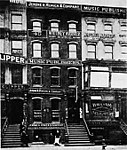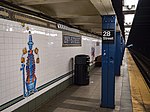Everard Baths
1888 establishments in New York (state)1986 disestablishments in New York (state)Building fires in New York CityBuildings and structures in ManhattanBurned buildings and structures in the United States ... and 9 more
Churches in ManhattanClosed churches in New York CityCommercial building firesFormer churches in New York (state)Gay bathhouses in New York CityHarv and Sfn no-target errorsLGBT history in New York CityMay 1977 events in the United StatesRomanesque Revival architecture in New York City

The Everard Baths or Everard Spa Turkish Bathhouse was a gay bathhouse at 28 West 28th Street in New York City that operated from 1888 to 1986. The venue occupied an adaptively reused church building and was the site of a deadly fire.
Excerpt from the Wikipedia article Everard Baths (License: CC BY-SA 3.0, Authors, Images).Everard Baths
West 28th Street, New York Manhattan
Geographical coordinates (GPS) Address External links Nearby Places Show on map
Geographical coordinates (GPS)
| Latitude | Longitude |
|---|---|
| N 40.7454 ° | E -73.9892 ° |
Address
West 28th Street 28
10001 New York, Manhattan
New York, United States
Open on Google Maps







